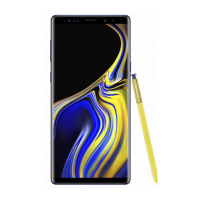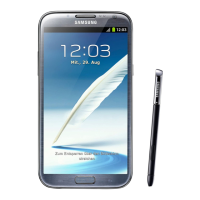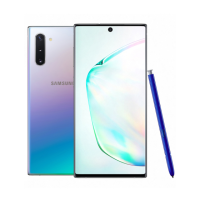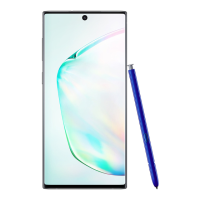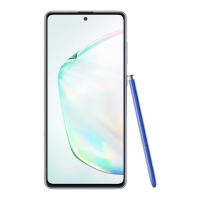Do you have a question about the Samsung Galaxy Note 4 SM-N910C and is the answer not in the manual?
Explanation of icons used to convey warnings, cautions, notices, and notes.
Lists items included in the device's product box.
Diagram and labels of the device's external components.
Introduction to the S Pen stylus and its functions.
Guides for inserting SIM/USIM cards and the battery into the device.
Instructions on connecting the charger and replenishing the battery.
Information about the device's built-in fast charging capabilities.
Steps for installing and managing external memory cards.
Procedures for powering the device on and off.
Methods to secure and access the device screen.
Explains how to interact with the touchscreen using gestures.
Describes the structure and elements of the device's home screen.
Customizing the home screen by adding, deleting, or rearranging items.
Overview of the screen displaying all installed applications.
Explains common icons appearing in the status bar.
Managing notifications and accessing quick settings.
How to launch applications from the home or all apps screen.
Steps for downloading, installing, and removing applications.
Options for disabling, enabling, hiding, or uninstalling apps.
Methods for typing and inputting text using the keyboard.
How to copy, cut, and paste text within the device.
Instructions on how to take screenshots of the device screen.
How to look up word definitions directly from the device.
Managing files and folders stored on the device or in cloud storage.
Features and modes to conserve the device's battery power.
How to access help guides for the device and its applications.
Accessing key S Pen features like Action memo and Smart select.
Creating memos and linking actions to written or drawn content.
Collecting specific content areas from the screen using the S Pen.
Drawing shapes to capture and crop parts of images.
Capturing screenshots and annotating them with the S Pen.
Creating and managing notes with rich content and multimedia.
General introduction to using the S Pen for interaction.
Previewing content by hovering the S Pen over screen items.
Selecting multiple items or text using the S Pen while holding the button.
Writing messages or filling forms using handwriting with the S Pen.
Using device movements and gestures for various functions.
Making calls by simply lifting the device to your ear.
Device vibrates when picked up after missed calls or new messages.
Muting calls or alarms by covering the screen with your palm.
Muting calls or alarms by turning the device over.
Capturing screenshots using a hand gesture across the screen.
Running multiple applications simultaneously in split or pop-up views.
Adjusting screen size for easier one-handed use.
Enhancing touchscreen responsiveness, especially with gloves.
Customizing home screen panels and the all apps screen layout.
Changing the device's wallpaper and notification sounds.
Setting up security measures like PIN, pattern, or password for screen lock.
Setting a pattern to unlock the device screen.
Setting a numeric PIN to unlock the device screen.
Setting an alphanumeric password for screen lock.
Registering fingerprints for device unlock and authentication.
Accessing features based on frequently visited locations.
Adding the My Places widget to the home screen for quick access.
Configuring location-specific shortcuts and features.
Managing fingerprint recognition for device security and authentication.
Step-by-step guide to register fingerprints on the device.
Hiding personal content like photos, videos, and files.
Accessing and viewing items hidden in private mode.
Removing items from private mode and making them visible again.
Switching to a simpler interface with larger icons and layout.
Switching back from Easy mode to the standard user interface.
Methods to migrate data from an old device to the new one.
Transferring data using Google or Samsung account backups.
Using Samsung's tool to transfer data between devices.
Transferring data from iPhone or Android devices using the mobile app.
Transferring data from a computer using Smart Switch.
Importing or backing up data using Samsung Kies software.
Creating and managing accounts for apps and services.
Steps to add new accounts like Google or Samsung.
Deleting existing accounts from the device.
Creating a Samsung account for device services and backup.
Making and receiving voice and video calls.
Instructions for initiating voice and video calls.
Dialing numbers directly from call history or contacts.
Calling contacts added to the favorites list.
Steps to dial international phone numbers.
How to answer or reject incoming calls.
Procedures for accepting incoming calls.
Procedures for declining incoming calls.
Viewing and managing calls that were not answered.
Features available during an active voice call.
Creating and managing contact information.
Methods for adding new contacts to the device.
Transferring contact lists from other phones.
Adding contact details one by one.
Finding saved contacts using search functions.
Sending and receiving text (SMS) and multimedia (MMS) messages.
Steps to compose and send text or multimedia messages.
Reading and managing message conversations.
Setting up and managing email accounts.
Configuring the device to send and receive emails.
Composing and sending email messages.
Accessing and reading received email messages.
Taking photos and recording videos.
Fundamental steps for capturing photos and videos.
Guidelines for responsible photography and videography.
Detailed steps for shooting photos and videos.
Quick access to the camera app from the lock screen.
Taking self-portraits using the front camera.
Using gestures or voice commands for hands-free selfies.
Capturing wider self-portraits to include more people.
Enhancing photo quality with rich colors and details in bright/dark areas.
Exploring various camera modes for different shooting scenarios.
Using the automatic camera mode for optimal photo settings.
Taking self-portraits using the rear camera with face detection.
Applying an out-of-focus effect to highlight subjects in photos.
Stitching photos together to create wide-scene images.
Customizing the display and order of camera shooting modes.
Acquiring additional camera shooting modes from GALAXY Apps.
Adjusting various camera configurations like flash, timer, and filters.
Viewing and managing photos and videos stored on the device.
Accessing and displaying media files in the Gallery.
Accessing media from Samsung Link or nearby devices.
Reducing battery consumption and restricting functions in emergency situations.
Steps to enable the emergency mode feature.
Steps to disable the emergency mode feature.
Quickly sending location and messages to emergency contacts.
Designating emergency contacts for help messages.
Configuring the content of emergency help messages.
Controlling the device using voice commands while driving.
Initial setup and activation of Car mode.
Adding multiple vehicles to Car mode for connection.
Navigating Car mode using voice commands or on-screen menus.
Getting directions and navigating to destinations via Car mode.
Searching for various content types on the device and online.
Using S Finder to locate files, apps, and information.
Customizing search categories for S Finder.
Deleting or disabling the saving of search history.
Managing schedules, events, and tasks.
Adding new calendar events and to-do list tasks.
Connecting S Planner with online accounts for data synchronization.
Managing wellness, fitness goals, and tracking progress.
Initial setup and activation of the S Health application.
Overview of the main interface and navigation within S Health.
Performing tasks using voice commands.
Initial setup and activation of the S Voice feature.
Changing the language used by S Voice.
Interacting with the device using voice commands.
Playing and managing music files.
Steps to play songs and control playback.
Streaming music from Samsung Link or nearby devices.
Watching and managing video files.
Steps to play videos and control playback.
Streaming videos from Samsung Link or nearby devices.
Browsing websites and searching for information online.
Navigating and interacting with web pages.
Recording audio memos and converting voice to text.
Steps for starting and managing audio recordings.
Selecting different modes for audio recording.
Setting alarms, world clocks, timers, and using the stopwatch.
Setting and managing alarms.
Procedures for creating new alarms.
Silencing or snoozing active alarms.
Removing existing alarms from the list.
Displaying times in different cities worldwide.
Adding new city clocks to the world clock feature.
Using the device as a stopwatch for timing events.
Setting countdown timers.
Performing mathematical calculations.
Saving and sharing files using Dropbox cloud storage.
Viewing personalized news and social media updates.
Using the device as a remote control for TVs and other devices.
Initial setup for using the Smart Remote feature.
Controlling TV functions like power, channels, and volume.
Creating, syncing, and sharing multimedia notes.
Posting and sharing sketches created with the S Pen.
Overview of Google applications available on the device.
Searching for information and browsing websites.
Sending and receiving emails via Gmail.
Sharing updates and photos with friends and family.
Finding locations and navigating using Google Maps.
Discovering, listening to, and sharing music.
Watching videos stored on the device or from the Play Store.
Downloading and reading books from the Play Store.
Reading news and magazines in a single location.
Downloading and playing games.
Storing and accessing files via Google Drive cloud storage.
Watching and sharing videos.
Managing photos and videos, including those uploaded to Google+.
Chatting with friends via text, images, and video calls.
Quick searching on the internet or device.
Searching using voice commands.
Configuring settings for Google features.
Automatically searching for and connecting to nearby devices.
Steps to establish a connection with other devices via Quick Connect.
Performing a new scan for available devices.
Turning off the Quick Connect functionality.
Sharing files and media with connected devices.
Exchanging data wirelessly with Bluetooth-enabled devices.
Steps to connect and pair the device with Bluetooth accessories.
Transferring files like contacts or media via Bluetooth.
Transferring an image file to another device via Bluetooth.
Accepting and saving an image sent from another device.
Removing previously paired Bluetooth devices.
Connecting devices directly via Wi-Fi without an access point.
Establishing connections with other devices using Wi-Fi Direct.
Sharing files via Wi-Fi Direct.
Accepting an image transferred via Wi-Fi Direct.
Disconnecting from Wi-Fi Direct enabled devices.
Reading information from NFC tags and making payments.
Activating and using NFC for payments and data transfer.
Using NFC for contactless payments after service registration.
Exchanging data using NFC via Android Beam or S Beam.
Displaying the device screen on a larger screen wirelessly.
Steps to connect and view device content on a TV via screen mirroring.
Disabling the screen mirroring feature.
Connecting the device to a vehicle's head unit for app control.
Steps to pair and connect the device to a car using MirrorLink.
Disconnecting the device from the vehicle after MirrorLink use.
Printing content from the device to a wireless printer.
Installing software for specific printer models.
Sending documents or images to a printer.
Keeping the device's software up-to-date.
Downloading software updates directly to the device.
Updating the device software using a computer and Samsung Kies.
Moving files between the device and a computer.
Connecting the device to a computer as a media storage device.
Managing device contents using Samsung Kies software.
Saving and retrieving personal information, apps, and settings.
Backing up data using a Google account.
Backing up data using a Samsung account.
Resetting the device to factory default settings and erasing all data.
Overview of device customization options through settings.
Accessing and adjusting various device configurations.
Creating a personalized list of frequently used settings.
Managing Wi-Fi, Bluetooth, and mobile data connections.
Connecting to and managing Wi-Fi networks.
Manually adding new Wi-Fi networks to connect to.
Automatically switching between Wi-Fi and mobile networks for stable connection.
Enabling and using Bluetooth for wireless data exchange.
Sharing the device's mobile data connection with other devices.
Setting up and using the device as a Wi-Fi hotspot.
Disabling all wireless functions for offline use.
Monitoring and managing mobile data consumption.
Configuring location services and permissions.
Managing NFC and various wireless sharing features.
Customizing advanced network settings like download booster and VPN.
Adjusting volume levels and sound settings for calls, media, and notifications.
Customizing screen brightness, wallpaper, font, and rotation.
Configuring screen lock methods, shortcuts, and effects.
Enabling and using the multi-window feature for multitasking.
Rearranging quick setting buttons on the notification panel.
Adjusting settings related to the S Pen functionality.
Activating motion recognition features for device interaction.
Managing Samsung, Google, and other user accounts.
Configuring sync, backup, and restore settings for cloud services.
Managing device data backup and reset options.
Switching to a simplified user interface mode.
Improving device usability for users with impairments.
Blocking notifications or calls from specific contacts.
Securing personal content by hiding it.
Managing fingerprint recognition settings for security and login.
Changing device language, keyboard, and text input methods.
Adjusting device time, date, and time zone settings.
Activating safety features like emergency mode and help messages.
Configuring settings for connected accessories like docks.
Activating and configuring power-saving modes.
Viewing memory information and managing storage.
Enhancing device security through various settings.
Accessing help information and guides for the device.
Viewing device information and software details.
Viewing and managing installed applications.
Selecting default apps for specific functions.
Customizing settings for individual applications.
Introduction to accessibility features for improved device usability.
Accessing accessibility menus quickly using the Home key.
Enabling screen reader functionality for auditory feedback.
Steps to turn on the TalkBack screen reader.
Steps to turn off the TalkBack screen reader.
Using finger gestures for navigation while TalkBack is active.
Customizing gestures for TalkBack navigation.
Setting up two-part vertical gestures for specific actions.
Assigning features to shortcut gestures.
Temporarily stopping voice feedback from TalkBack.
Assigning labels to images for screen reader recognition.
Adjusting TalkBack preferences like speech volume and keyboard echo.
Having the device read passwords aloud during input.
Configuring text-to-speech options like engine and speech rate.
Using the keyboard with auditory feedback for text input.
Accessing special characters via a pop-up window on the keyboard.
Features to improve visual clarity and magnification.
Adjusting the size of text displayed on the screen.
Zooming in on specific screen areas for better visibility.
Magnifying screen content by hovering a pen over it.
Setting alerts for unread notifications at specified intervals.
Inverting screen colors for improved readability.
Adjusting screen colors for users with color vision difficulties.
Features to assist users with hearing impairments.
Using the camera flash for incoming call and notification alerts.
Muting all device sounds, including calls and media.
Configuring closed captioning options for media.
Balancing audio output between left and right headset channels.
Combining stereo sound into a single mono output.
Detecting sounds like baby crying or doorbells.
Alerting the user when a baby's cry is detected.
Detecting and alerting to doorbell sounds.
Customizing vibration and flash notifications.
Vibrating the device in sync with sounds during media playback or button taps.
Features to assist users with physical dexterity challenges.
Displaying an assistive shortcut icon for quick access to menus.
Enabling and positioning the assistive shortcut icon.
Navigating the assistive menus via the shortcut icon.
Controlling the screen using a touch-sensitive cursor area.
Activating advanced assistive menus for specific apps.
Waking the device screen using hand gestures.
Adjusting the time recognition for tap-and-hold actions.
Restricting device interaction to prevent accidental inputs.
Customizing methods for answering or ending calls.
Stopping alarms or answering calls with a single tap.
Saving, importing, and sharing accessibility configurations.
Exporting current accessibility settings to a file.
Importing accessibility settings from a file.
Sharing accessibility settings via various methods.
| Model | SM-N910C |
|---|---|
| Announced | 2014, September |
| Technology | GSM / HSPA / LTE |
| 2G bands | GSM 850 / 900 / 1800 / 1900 |
| 3G bands | HSDPA 850 / 900 / 1900 / 2100 |
| 4G bands | LTE band 1(2100), 3(1800), 5(850), 7(2600), 8(900), 20(800) |
| Speed | HSPA 42.2/5.76 Mbps, LTE Cat4 150/50 Mbps |
| GPRS | Yes |
| EDGE | Yes |
| Dimensions | 153.5 x 78.6 x 8.5 mm (6.04 x 3.09 x 0.33 in) |
| Weight | 176 g (6.21 oz) |
| SIM | Micro-SIM |
| Display Type | Super AMOLED |
| Display Size | 5.7 inches |
| Multitouch | Yes |
| Protection | Corning Gorilla Glass 3 |
| OS | Android 4.4.4 (KitKat), upgradable to 6.0.1 (Marshmallow) |
| Chipset | Exynos 5433 |
| GPU | Mali-T760MP6 |
| Internal Storage | 32 GB |
| RAM | 3 GB |
| Main Camera Features | LED flash, panorama, HDR |
| Alert types | Vibration; MP3, WAV ringtones |
| Loudspeaker | Yes |
| 3.5mm jack | Yes |
| WLAN | Wi-Fi 802.11 a/b/g/n/ac, dual-band, Wi-Fi Direct, hotspot |
| GPS | Yes, with A-GPS, GLONASS, BDS |
| NFC | Yes |
| Infrared port | Yes |
| Sensors | Fingerprint (front-mounted), accelerometer, gyro, proximity, compass, barometer, gesture, UV, heart rate, SpO2 |
| Messaging | SMS (threaded view), MMS, Email, Push Email, IM |
| Browser | HTML5 |
| Java | No |
| S Pen Support | Yes |
| Status | Available |
| Resolution | 1440 x 2560 pixels |
| Card slot | microSD |
| Main Camera | 16 MP |
| Video | 2160p@30fps, 1080p@60fps |
| Secondary Camera | 3.7 MP, f/1.9 |
| Bluetooth | 4.1, A2DP, LE |
| Radio | FM radio |
| USB | microUSB 2.0 |
| Battery | 3220 mAh |
| Talk time | Up to 20 h (3G) |
| Music play | Up to 80 hours |
| Colors | Charcoal Black, Bronze Gold, Blossom Pink |
| SAR EU | 0.40 W/kg (body) |
| CPU | Octa-core (4x1.3 GHz Cortex-A53 & 4x1.9 GHz Cortex-A57) |



